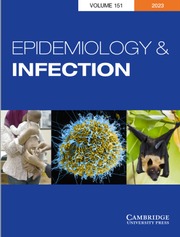Crossref Citations
This article has been cited by the following publications. This list is generated based on data provided by Crossref.
Rose, Joan B.
and
Clark, C. Scott
1986.
Microbial aspects of wastewater reuse for irrigation.
Critical Reviews in Environmental Control,
Vol. 16,
Issue. 3,
p.
231.
Spillmann, S K
Traub, F
Schwyzer, M
and
Wyler, R
1987.
Inactivation of animal viruses during sewage sludge treatment.
Applied and Environmental Microbiology,
Vol. 53,
Issue. 9,
p.
2077.
Chalapati Rao, V.
Metcalf, Theodore G.
and
Melnick, Joseph L.
1987.
Removal of indigenous rotaviruses during primary settling and activated-sludge treatment of raw sewage.
Water Research,
Vol. 21,
Issue. 2,
p.
171.
Bosch, Albert
Pinto, Rosa M.
Blanch, Anicet R.
and
Jofre, Juan T.
1988.
Detection of human rotavirus in sewage through two concentration procedures.
Water Research,
Vol. 22,
Issue. 3,
p.
343.
Holmes, Ian H.
1988.
Laboratory Diagnosis of Infectious Diseases Principles and Practice.
p.
384.
Chalapati Rao, V
Metcalf, TG
and
Melnick, JL
1988.
Chemical and Biological Characterization of Municipal Sludges, Sediments, Dredge Spoils, and Drilling Muds.
p.
282.
Kaspar, Charles W.
and
Tartera, Carmen
1990.
Techniques in Microbial Ecology.
Vol. 22,
Issue. ,
p.
497.
Gerba, Charles P.
Rose, Joan B.
Haas, Charles N.
and
Crabtree, Kristina D.
1996.
Waterborne rotavirus: A risk assessment.
Water Research,
Vol. 30,
Issue. 12,
p.
2929.
Kobayashi, Yumi
Peters, Greg M.
Ashbolt, Nicholas J.
Heimersson, Sara
Svanström, Magdalena
and
Khan, Stuart J.
2015.
Global and local health burden trade-off through the hybridisation of quantitative microbial risk assessment and life cycle assessment to aid water management.
Water Research,
Vol. 79,
Issue. ,
p.
26.
Yasui, Nobuhito
Suwa, Mamoru
Sakurai, Kensuke
Suzuki, Yutaka
Tsumori, Jun
Kobayashi, Kentaro
Takabatake, Hiroo
Lee, Sun Tae
Yamashita, Naoyuki
and
Tanaka, Hiroaki
2016.
Removal characteristics and fluctuation of norovirus in a pilot-plant by an ultrafiltration membrane for the reclamation of treated sewage.
Environmental Technology,
Vol. 37,
Issue. 21,
p.
2793.
Elahi, Ehsan
Abid, Muhammad
Zhang, Liqin
and
Alugongo, Gibson Maswayi
2017.
The use of wastewater in livestock production and its socioeconomic and welfare implications.
Environmental Science and Pollution Research,
Vol. 24,
Issue. 21,
p.
17255.
Nagelkerke, Erwin
Hetebrij, Wouter A.
Koelewijn, Jaap M.
Kooij, Jannetje
van der Drift, Anne-Merel R.
van der Beek, Rudolf F. H. J.
de Jonge, Eline F.
and
Lodder, Willemijn J.
2023.
PCR standard curve quantification in an extensive wastewater surveillance program: results from the Dutch SARS-CoV-2 wastewater surveillance.
Frontiers in Public Health,
Vol. 11,
Issue. ,
Morales-Mora, Eric
Centeno-Mora, Erick
Barrios-Hernández, Mary Luz
and
Chacon, Luz
2025.
Wastewater Treatment Plants.
Vol. 130,
Issue. ,
p.
137.

